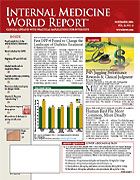Publication
Article
Internal Medicine World Report
Consider TIA a Signal for Needed Intervention
Consider TIA a Signal for Needed Intervention
By Wayne Kuznar
New Orleans—Patients with transient ischemic attack (TIA) are receiving less diagnostic testing, treatment, and education compared with those with stroke, according to the results of a retrospective study presented at the American Stroke Association’s International Stroke Conference 2005.
Lead investigator Bhuvaneswari Dandapani, MD, medical director of the stroke center at Holmes Regional Medical Center, Melbourne, Fla, said that the findings represent a “missed opportunity” to prevent disability or death. “TIA is an opportunity to intervene, not to ignore,” she said. “There needs to be a paradigm shift in the way the public and physicians look at TIA.”
Included in the study were 185 patients consecutively admitted with stroke or TIA. Risk factors, diagnostic testing, medications, and patient education were compared. The median length of stay was 3 days for TIA patients and 5 days for stroke patients. Only 10% of the TIA patients had had a previous stroke or TIA compared with 36% of the stroke patients.
Nearly all patients in both groups had a brain computed tomography scan and magnetic resonance imaging with or without magnetic resonance angiography. However, other tests were performed significantly less often in the TIA patients. Carotid Doppler was performed in 76% of stroke patients but only 54% of TIA patients (P = .002), transcranial Doppler was performed in 8% of stroke patients and 2% of TIA patients (P = .097), 60% of stroke patients and only 34% of TIA patients underwent echocardiography (P = .001), and 12% of stroke patients and 1% of TIA patients had transesophageal echocardiography (P = .003).
The rates of antiplatelet and anticoagulant therapy were similar, but TIA patients were discharged less often with angiotensin-converting enzyme inhibitors (12% vs 26%) and calcium antagonists (13% vs 34%). Also, the rates of documented stroke education were 67% among stroke patients, but only 35% among the TIA patients.
“For 90% of the TIA patients, it was their first event and the first opportunity to intervene,” said Dr Dandapani. “We have to do a better job of managing these patients.”
Because many TIA patients do not seek immediate medical attention, “we may be seeing only the tip of the iceberg,” she said. Physicians need to recognize TIA as an emergency; 10.5% of patients who present to the emergency department with a TIA have a stroke within 90 days, mostly within the first 48 hours.
Data from 7500 patients participating in the Framingham Study or the Framingham Offspring Study show that persons with a TIA have 5 times the risk of subsequent stroke over 10 years than those without TIA, reported Cristina Ivan, MD, of Boston University. About 22% of the overall risk was in the first week following TIA, she said.
The risk of stroke increased with the number of symptoms that accompanied the TIA, said Dr Ivan, such that occurrence of ³2 symptoms was associated with an 8-fold increased risk of stroke compared with no symptoms, and 1 symptom increased the risk by 3.5 times. Common symptoms reported were motor, sensory, speech, and visual.
